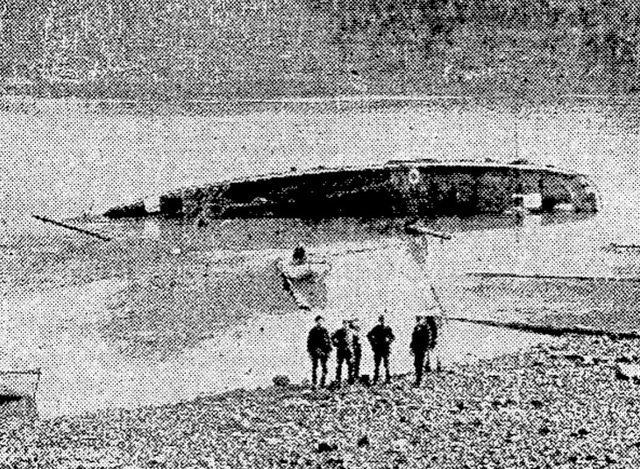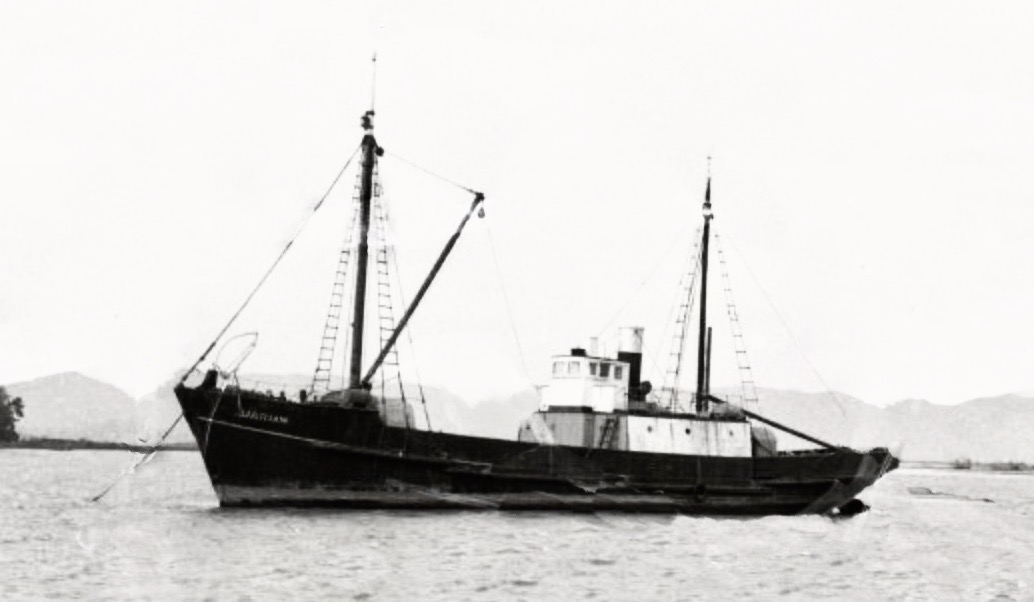Kiwi songs - Maori songs - Home
The Ronga was a very swift coastal schooner prone to
capsizing.
It was converted first to steam power, and then to
diesel.
|
The Ronga was a schooner You could hardly call a winner A floating jinx, a disaster A storm in Pelorus Sound Turned the Ronga upside down Could anybody - save her? Oh we thought she was a goner
But we're going to right the Ronga In the mor-or-ning She's a plucky little boat But she's hard to keep afloat Still we're going to right the Ronga anyway A year went past It should have been her last A wonderful - repeat performance A new squall, same Sound Over she went upside down Not bad luck, just chance. Four years went by When a flock of albatri Saw the Ronga sailing off Cape Cam - bell They waved a four leaf clover But before the day was over An albatross was sitting on her barnacles Oh we thought she was a goner
But we're going to right the Ronga In the mor-or-ning She's a plucky little boat But she's hard to keep afloat Well we're going to right the Ronga anyway She was turned into a steamer On the Manawatu River They even changed her name What a shame! The collision made her sink To the bottom of the drink Must have been a mermaid I think Twelve more accidents Eventually providence Pulled the plug - on little Ro-nga She was gutsy, she was brave (but) In the end they couldn't save her A fire burnt the Ronga to a goner Oh we thought she was a goner
But we're going to right the Ronga In the mor-or-ning She's a plucky little boat But she's hard to keep afloat Well we're going to right the Ronga anyway |
Righting the Ronga on record Julie Collier's other
historical songs cover a wide range of events, in a wide range
of styles, and are equally enjoyable to listen to.
WORK
IN PROGRESS - NEWS CLIPPINGS FROM PAPERS PAST
The schooner Ronga   ' The 'Ronga' was a wooden 2 mast schooner, 104 gross tons, 93 net tons, 98.5 x 23.0 x 7.1. feet. She was built 1900 by Thomas M Lane, of Totara North, New Zealand for owners in Lyttelton. In 1909 the vessel was converted into a single screw steamship and renamed 'Wairau,' Subsequently she was converted into a motorship of the same name. 17 MAY 1911 THE WAIRAU AND THE HIMITANGI. THE WAIRAU DAMAGED AND STRANDED. THE CREW SAFE. [United Press Association,) PALMERSTON N., Wednesday. The steamers Himitangi and Wairau collided in a narrow channel of the Manawatu river at midnight last night. The Wairau was struck amidships, and slewed round with her stern on to the bank, where she now lies with her bows under water. The crew of nine got safely ashore with their baggage. The Himitangi apparently was uninjured, and preceded to Wanganui. The Wairau was coal laden, and was inward bound. Details as to how the collision occurred are not yet ascertainable. It is surmised that there will be no difficulty in getting the vessel off, but there will be a difficulty in getting the cargo of coal out, the steamer being submerged to about amidships at low water. Rongo side up: The Wairau lacked the charm and appeal of her consort the Echo and her main claim to fame was that, amongst many other misadventures, she had capsized three times during her long career with considerable loss of life on the third time. Although starting life named Rongo, a topsail schooner, her rigging was gradually reduced after each mishap until she finished up as a small steam ship in 1910. This did not see and end to her misfortunes and in 1911 she was rammed by the Himatangi in the Manawatu River, drifted ashore and sank. Following repairs Rongo was purchased by Eckford & Co. and renamed Wairau in 1912. She was added to the Wellington - Blenheim fleet and happily managed to stay the right way up from then on. While the Echo continued in that trade the Wairau was often laid up through a shortage of cargo during the 1930’s depression. For a time during the war she also was chartered by the Navy and carried out the duties of examination vessel for ships entering and leaving Wellington Harbour. In 1946 the Wairau was converted at Nelson from steam ship to motor ship with a 250hp Vivian diesel giving her a service speed of 10 knots. This was a very smart speed in those days and quite a talking point among the maritime fraternity. Many larger vessels were struggling to do 9 knots during that era. Eckford’s then employed her on a triangular run between Blenheim, Wellington and Lyttelton. She had a draft of 6.5 to 7 feet which eventually became too deep for the Wairau bar and the Opawa River which was slowly silting up. She was laid up inside the Wairau bar in the mid 1950’s sold in the early 60’s but never put to use and eventually ended her life on the mudflats at Motueka. ref Wairau was built in Whangaroa in 1900. She was hulked at Motueka and and destroyed by fire about 1973. THE WAIRAU , ROMANTIC CAREER I iYTTBLTON - WEL LIX f i TON* TfECORI) (By A. L. Kirk.) . Many .an ugly steuuier once spread wings to the -winds, but owing to the march of progress, the necessity of keeping to a time-table, or perhaps owing to a mishap, her sails havo been taken from her. The Wairau was one of these, for once she was a speedy schooner, and according to Basil I/üblock, tho Bonga, as she was then called, was the clipper of the fleet of schooners that frequented Wellington Harbour. Other vessels, such aa the Mararoa and tho Hinoinoa, used to carry canvas atone time, but they were fullpowered steamers, and only kept their sails as a safety measure in caso of breakdowns. The Wairau, however, had no engines. As the Eonga, the vessel'"was builf in. 1900 bv'.T.'N. Lane at Totara North, aud her principal measurements are: . Length, 98.7 ft; breadth, 23ft; depth, 7.lft; and a gross tonnage of 138. In.' the September of 1900 she made the, passage between Lyttelton and Wellington in the record time, for sailing ships, of 18 hours, a very favourable' comparison with the times taken by the ill-fated' Manuka whilst relieving on that run. In t!»o following year she was being overhauled at Pelorus Sound, and had .her ballast out, when ' she was struck by a. squall and put on, her beam-ends. With such fury did this squall strike tho vessel that it took a considerable time to Tight her again. As a result her owners decided to have the masts cut down by nine feet. The next event of importance in the W&irau's career was in 1900, when she and the American four-masted barque Addona loft Lyttelton together one afternoon. The Kongn. was bound for Havelock in ballast, and the Addena for Newcastle. A southerly blew up, and before long a terrible storm was raging, accompanied by a high sea. The Addena ran ashore.at Palliscr Bay, and became a total wreck. The tragedy of that storm, however," was not discovered till later, when tho Ronga was found. She was floating upside-down off tho coast, and there ■ was no sign of her skipper, Mi1. .Ned Petersen, or her ciew of seven. Sho was towed into Welling-, ton,.righted,.and then sold. j The Eonga's new owners .started to : alter, her, and when they had' finished i one would never have known her for the i same ship. Her masts were cut down I further, she lost her bowsprit, and I finally her degradation was complete: ] ■ihewas turned into a steamer and renamed. The firm of William Cable built her engines, which have not so far been, replaced. Although she has been running twenty-four years. since then, the Waii-au has had few events of note in her history. Occasionally she has iouched -on the /Wairau Bar, but has suffered no major damage. However, in 1929' she took part in the funeral of one of the oldest stedmors '.hen afloat, the Kennedy. The Keifnedy had;run on tho JToxton beach, and as on her- being refloated and surveyed jihe was 'found to be so extensively damaged that the cost of repairing her would. be prohibitive, she was sold to Gckford and Co. This firm strippped her df anything valuable, and then decided she was to be used to accompany tho Waverley as a floating dam on the Wairau' Bar. One oarly morning the Wairau slipped the tow-line on board the Kennedy, and towed her out of tho harbour across the Straits, and finally left her on the Wairau Bar, where sha is Still useful helping to deflect the (iurrent. Since the Konga hud her top-masts removed, very few of the scows which trade out of Wellington have had top--niasta, on account of the squally weather met in the Straits. In Auckland, however, nearly all the seowa have top-masts. Tho Aloa, which recently came down-from'Auckland,.did not retain her top-masts very long, for they wore soon dispensed with. The Wairau has still years o£ u&etlul bervico bofore her, but' if some of her old ■ crew could see her to-day they would stand and marvel at the dirty coaster that was once the smart schooner which held the Lytlelton-Wellingtou record'for sailing vessels. 1945 MOTOR VESSEL WAIRAU SUCCESSFUL CONVERSION FROM STEAM SHIP WITH EVENTFUL HISTORY The vessel Wairau, which has been on a Nelson slipway for the past four months undergoing a compl te refit, yesle day ca r ed out successful open water trials alter being converted from steam to Diesel power. This was the largest conversion job ever undertaken in Nelson. Originally the topsail schooner Ronga, the vessel has seen more than 40 years of eventful service in the New Zealand coastal trade. Three times she capsized during bad weather, on one occasion the whole crew being lost without trace. Converted to a steamer in the early nineteen hundreds and re-named the Wairau, the vessel’s run of bad luck continued and she collided with another steamer in the Manawatu River and was again sunk. Owned by T. Eckford and Company, Ltd., Blenheim, the Wairau has been engaged for many years on the Blen-heim-Wellington-Lyttelton run. The speed developed by the Wairau on its trials was a little better than nine knots at 450 revolutions. With 50 revolutions still in hand this is a big advance on its former speed of 6£ knots. The vessel’s carrying capacity has also been increased by the fitting of the new engines. The empty weight of the old engine and boiler was about 13 tons—the same as the present diesel motor—but when fully fuelled with coal and water the weight was approximately doubled. The result is that instead of drawing seven feet of water at the stern when empty, the vessel is now drawing only six feet. This will be a big advantage when using river ports such as Blenheim. The Wairau has been fitted with the latest type of diesel engine— a Cana-dian-built six-cylinder, 240h.p. motor developing 500 revolutions per minute. Its fuel consumption is ten gallons an hour, so that with a storage capacity of 1200 gallons the vessel is capable of 120 hours’ steaming. In addition to the engine refit, the vessel’s accommodation has been completely gutted and rebuilt. The hold has been enlarged and big improvements made in the crew’s quarters. The hull has been refastened right through, some 4000 bolts being used for this work. The kauri timbering of the hull was found to be as solid as the day the vessel was built. Webpage
put onto folksong.org.nz website APRIL 2021 |
